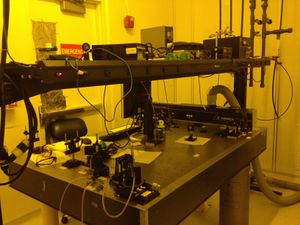Holographic Lith/PL Setup (Custom): Difference between revisions
(→Detailed Specifications: added max sample size) |
(header level set correctly, link to recipes page) |
||
| Line 10: | Line 10: | ||
|toolid=35 |
|toolid=35 |
||
}} |
}} |
||
=About= |
==About== |
||
The interference lithography system (aka. Holography) at UCSB uses a 15mW, single-mode, 325 nm HeCd laser that is filtered and expanded by pinhole filters to produce the large area exposure beam. The system uses a simple mirror configuration with a fixed 90 degree angle between the mirror and sample. The entire mirror/sample assembly is rotated in 0.1 degree increments to change the grating pitch from ~ 200 nm to ~ 280 nm (35 to 55 degrees) over an ~ 2 cm x 2 cm exposure area. |
The interference lithography system (aka. Holography) at UCSB uses a 15mW, single-mode, 325 nm HeCd laser that is filtered and expanded by pinhole filters to produce the large area exposure beam. The system uses a simple mirror configuration with a fixed 90 degree angle between the mirror and sample. The entire mirror/sample assembly is rotated in 0.1 degree increments to change the grating pitch from ~ 200 nm to ~ 280 nm (35 to 55 degrees) over an ~ 2 cm x 2 cm exposure area. |
||
[[Lithography Recipes#Chemicals Stocked .2B Datasheets|THMR-3600HP]] resist spin-coated to ~ |
[https://wiki.nanofab.ucsb.edu/w/images/3/33/XHRiC-Anti-Reflective-Coating.pdf XHRiC] bottom anti-reflection coating (BARC) & [[Lithography Recipes#Chemicals Stocked .2B Datasheets|THMR-3600HP]] imaging resist spin-coated to ~80 nm thickness is used for grating exposure. 2-D gratings can be formed by rotating the sample and doing multiple exposures. Total exposure times are controlled by a manual shutter and are generally several minutes in length. |
||
A photoluminescence measurement setup is co-located on the optical table. Please see the page for the PL system for more info: |
A photoluminescence measurement setup is co-located on the optical table. Please see the page for the PL system for more info: |
||
| Line 19: | Line 19: | ||
*[[Photoluminescence PL Setup (Custom)]] |
*[[Photoluminescence PL Setup (Custom)]] |
||
=Detailed Specifications= |
==Detailed Specifications== |
||
*15 mW single TEM mode HeCd laser |
*15 mW single TEM mode HeCd laser |
||
| Line 25: | Line 25: | ||
*~ 2 cm x 2 cm uniform exposure area |
*~ 2 cm x 2 cm uniform exposure area |
||
*~ several minute exposure times |
*~ several minute exposure times |
||
*Grating period adjustable from ~200 to ~280 nm with |
*Grating period adjustable from ~200 to ~280 nm with rotation stage |
||
== Recipes == |
|||
* [[Lithography Recipes#Holography%20Recipes|Lithography Recipes > Holography Recipes]] - developed recipes for 1D (line/space) and 2D (pillars) gratings. |
|||
Revision as of 23:46, 20 September 2023
|
About
The interference lithography system (aka. Holography) at UCSB uses a 15mW, single-mode, 325 nm HeCd laser that is filtered and expanded by pinhole filters to produce the large area exposure beam. The system uses a simple mirror configuration with a fixed 90 degree angle between the mirror and sample. The entire mirror/sample assembly is rotated in 0.1 degree increments to change the grating pitch from ~ 200 nm to ~ 280 nm (35 to 55 degrees) over an ~ 2 cm x 2 cm exposure area.
XHRiC bottom anti-reflection coating (BARC) & THMR-3600HP imaging resist spin-coated to ~80 nm thickness is used for grating exposure. 2-D gratings can be formed by rotating the sample and doing multiple exposures. Total exposure times are controlled by a manual shutter and are generally several minutes in length.
A photoluminescence measurement setup is co-located on the optical table. Please see the page for the PL system for more info:
Detailed Specifications
- 15 mW single TEM mode HeCd laser
- Max sample size: ~1.5 inch square
- ~ 2 cm x 2 cm uniform exposure area
- ~ several minute exposure times
- Grating period adjustable from ~200 to ~280 nm with rotation stage
Recipes
- Lithography Recipes > Holography Recipes - developed recipes for 1D (line/space) and 2D (pillars) gratings.
